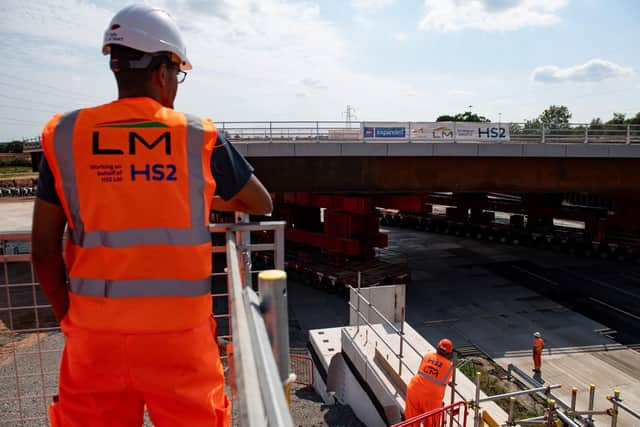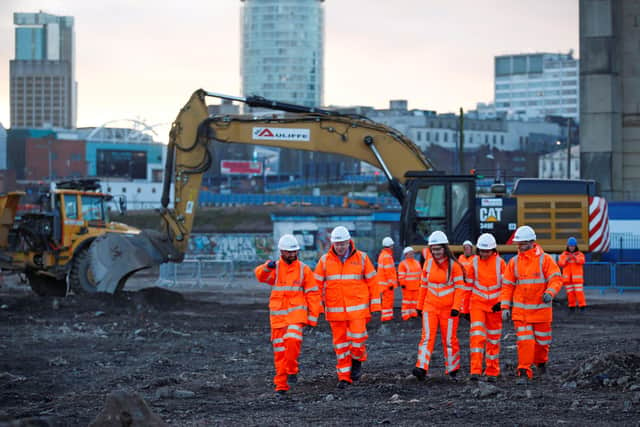How HS2 can help UK tackle climate change: Ralph Smyth
Representing a huge departure from decades of government policy, the Department for Transport is consulting on its Transport Decarbonisation Plan, the central commitment of which is to reduce car use by making public and active transport the first choice for daily travel.
This is the first time a British government has offered such a radical pledge, and its significance cannot be understated.
Advertisement
Hide AdAdvertisement
Hide AdThere is, however, one major problem. Because its analysis was based on trip numbers rather than carbon emissions, the consultation’s focus is on daily travel, missing out less regular but longer travel that actually makes up the majority of emissions.


In its 2020 annual report to Parliament, the Committee on Climate Change stressed the importance of each sector having a “well-designed, coherent and effective package of policies to deliver a high level of ambition”. In its response to the consultation, industry body the High Speed Rail Group, has explained why the TDP will only deliver the reduction needed with new investment and explicit policies to make rail the longer distance mode of choice.
Already only three out of ten trains in Britain are unable to run on electricity but it is often those making longer journeys away from the South-East that are still chugging along on diesel. So central to this investment should be the delivery of a national high speed rail network forming the backbone of a world class public transport system.
A core network of dedicated high speed lines, like HS1 and HS2, provide the necessary capacity for rail travel to grow between our biggest urban areas, integrated with electrified and digitally signalled routes offering competitive journey times between our cities. Transformational upgrades are critical for climate mitigation – to ensure journey times by rail are competitive against driving or flying – and for climate adaptation. Some of our key railways are nearly 200 years old and at far greater risk of disruption from sea level rise and extreme weather than roads.
Advertisement
Hide AdAdvertisement
Hide AdWe can be inspired here by the enormous successes of HS1. Eurostar reduces CO2 emissions by the equivalent of 60,000 short-haul flights every year, while leisure travel on its domestic Javelin services increased ninefold between 2010 and 2016 and with the space it freed up on south London railways, Thameslink has introduced a range of new connections. Perhaps most impressive of all though is that from 2013 to 2018, just nine trains were delayed on HS1 due to severe weather.


Opening a high capacity, higher speed and resilient rail connection between England and Scotland by the early 2030s would help enable Britain to double rail freight, as SNCF is now proposing for France.
HS2 will be transformative not just for these longer journeys, but also by enabling the full potential of existing railways to cater for local travel. Journeys that are 10-25 miles long are responsible for a quarter of emissions. HS2 will free up existing railways, enabling them to cater better for shorter journeys, and is already catalysing wider improvements to sustainable travel. For instance, proposals for the East Midlands Hub at Toton include new local rail and tram routes plus the creation of safe and appealing walking and cycling connections, forming a network between surrounding towns and villages. Enabling door-to-door low carbon journeys is not just about the stations, for instance the design specification for HS2 trains includes a requirement for on train cycle storage to allow charging of e-bikes.
With almost two-thirds of emissions from longer trips of over 50 miles coming from leisure or visiting friends and family, public transport will remain crucial post-pandemic. While day-to-day commuting may reduce in at least the short-term as a result of the virus, a desire for face-to-face interactions with our family and friends, or for holidays to escape far away from our screens, will not. This is why it is so essential when formulating its plan, the Government does not simply focus on commuting and other daily activities, but considers travel in its broadest sense, domestic and international.
Advertisement
Hide AdAdvertisement
Hide AdIf the Government wants to go the distance in its mission to achieve net zero, a commitment to make rail the natural first mode of choice for longer journeys must be there from the start.
Ralph Smyth is lead author of a High Speed Rail Group report on decarbonisation
Editor’s note: first and foremost - and rarely have I written down these words with more sincerity - I hope this finds you well.
Almost certainly you are here because you value the quality and the integrity of the journalism produced by The Yorkshire Post’s journalists - almost all of which live alongside you in Yorkshire, spending the wages they earn with Yorkshire businesses - who last year took this title to the industry watchdog’s Most Trusted Newspaper in Britain accolade.
Advertisement
Hide AdAdvertisement
Hide AdAnd that is why I must make an urgent request of you: as advertising revenue declines, your support becomes evermore crucial to the maintenance of the journalistic standards expected of The Yorkshire Post. If you can, safely, please buy a paper or take up a subscription. We want to continue to make you proud of Yorkshire’s National Newspaper but we are going to need your help.
Postal subscription copies can be ordered by calling 0330 4030066 or by emailing [email protected]. Vouchers, to be exchanged at retail sales outlets - our newsagents need you, too - can be subscribed to by contacting subscriptions on 0330 1235950 or by visiting www.localsubsplus.co.uk where you should select The Yorkshire Post from the list of titles available.
If you want to help right now, download our tablet app from the App / Play Stores. Every contribution you make helps to provide this county with the best regional journalism in the country.
Sincerely. Thank you.
James Mitchinson
Editor
Comment Guidelines
National World encourages reader discussion on our stories. User feedback, insights and back-and-forth exchanges add a rich layer of context to reporting. Please review our Community Guidelines before commenting.